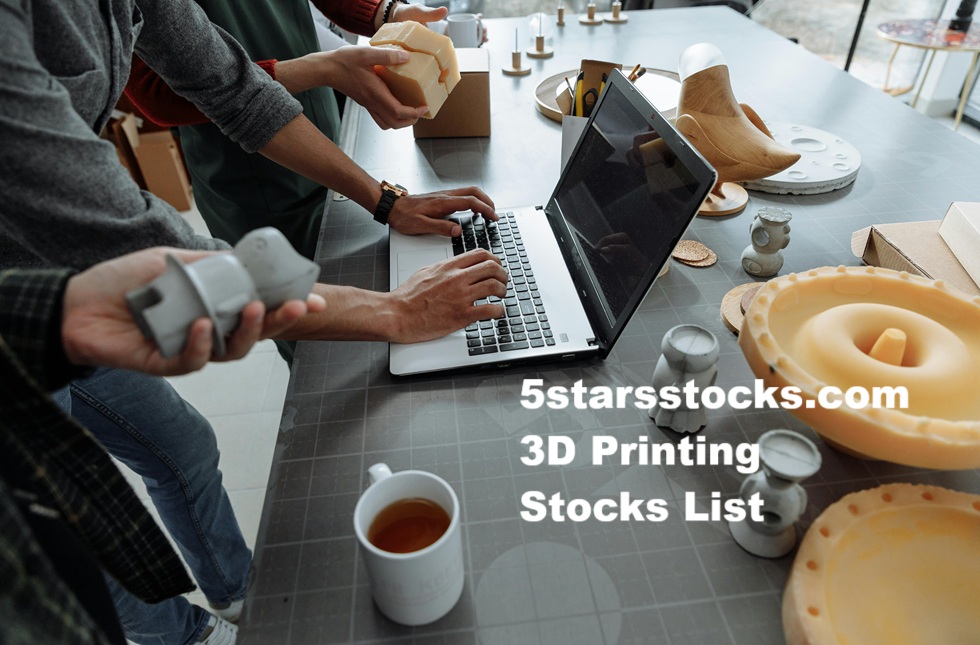The 3D printing industry is experiencing unprecedented growth, with market projections showing expansion from $23.4 billion in 2025 to an astounding $101.7 billion by 2032—representing a compound annual growth rate of 23.4%. This explosive growth has captured the attention of forward-thinking investors seeking exposure to transformative technologies that are reshaping manufacturing across multiple industries.
5starsstocks.com has emerged as a valuable resource for investors looking to navigate the complex landscape of 3D printing stocks. With their systematic approach to evaluating emerging technology companies, the platform provides crucial insights into which additive manufacturing stocks offer the best potential for long-term growth while helping investors understand the inherent risks in this rapidly evolving sector.
As traditional manufacturing faces disruption from additive manufacturing technologies, companies specializing in 3D printing are positioning themselves at the forefront of a industrial revolution. From aerospace components to medical devices, 3D printing is moving beyond prototyping to become a cornerstone of modern production methods, creating compelling investment opportunities for those who understand the landscape.
The 3D Printing Revolution: Market Size and Growth Projections
The 3D printing market has evolved dramatically from its origins as a prototyping tool to become a comprehensive manufacturing solution. Industry analysts project remarkable growth driven by technological advancements, cost reductions, and expanding applications across diverse sectors.
Market Statistics and Future Outlook
Current market valuations underscore the sector’s tremendous potential. Fortune Business Insights estimates the additive manufacturing market reached $19.3 billion in 2024, with projections showing sustained growth at a 23.4% CAGR through 2032. This growth trajectory reflects increasing adoption across industries that previously relied exclusively on traditional manufacturing methods.
The market expansion is being driven by several key factors including supply chain localization trends, sustainability initiatives, and the growing demand for customized products. Post-COVID supply chain disruptions have accelerated interest in localized manufacturing capabilities, making 3D printing an attractive solution for companies seeking to reduce dependence on global supply networks.
Investment interest has reached institutional levels, with Cathie Wood’s ARK Invest launching The 3D Printing ETF (PRNT) to provide investors with diversified exposure to the sector. This institutional validation demonstrates growing confidence in the technology’s long-term prospects and commercial viability.
Industrial Applications Driving Growth
Aerospace and automotive manufacturing represent the largest commercial applications for 3D printing technology. Companies like Stratasys produce components for commercial aircraft, while Desktop Metal works with major automotive manufacturers including Ford, BMW, and Toyota to create both prototypes and production parts.
Healthcare applications are expanding rapidly, encompassing everything from custom prosthetics to dental appliances and surgical instruments. The ability to create patient-specific medical devices and anatomical models for surgical planning represents a significant growth driver for the industry.
Consumer goods and rapid prototyping continue to benefit from 3D printing’s ability to accelerate product development cycles and enable mass customization. This application spans industries from fashion and jewelry to electronics and household goods.
5starsstocks.com’s Analysis Methodology for 3D Printing Investments
5starsstocks.com applies its proprietary five-star rating system to evaluate 3D printing stocks, providing investors with comprehensive analysis that goes beyond traditional financial metrics to include technology-specific factors crucial for success in this emerging sector.
Five-Star Rating System Application
The platform’s financial health assessment for 3D printing companies considers unique factors such as research and development spending ratios, intellectual property portfolios, and cash burn rates typical of technology companies transitioning from development to commercialization phases.
Growth potential evaluation incorporates analysis of addressable market sizes, competitive positioning within specific 3D printing technologies, and strategic partnerships that could accelerate market penetration. The platform examines each company’s ability to scale production and achieve profitability as demand increases.
Risk analysis for 3D printing stocks includes assessment of technological obsolescence risks, competitive threats from both established players and emerging startups, and regulatory challenges that could impact adoption in critical industries like aerospace and healthcare.
Sector-Specific Analysis Factors
Technology innovation and patent portfolios receive special attention, as intellectual property often determines competitive advantages in rapidly evolving technical fields. 5starsstocks.com evaluates the strength and breadth of each company’s patent holdings and their potential for licensing revenue.
Manufacturing scalability analysis examines each company’s ability to transition from small-scale production to industrial manufacturing volumes. This includes assessment of production capacity, supply chain partnerships, and operational efficiency improvements.
Strategic partnerships and customer relationships play crucial roles in 3D printing success, as companies often rely on collaborations with established manufacturers to gain market access and validate their technologies in real-world applications.
5starsstocks.com’s Top 3D Printing Stocks to Watch
Based on 5starsstocks.com’s comprehensive analysis methodology, several 3D printing companies stand out as particularly compelling investment opportunities for 2025, each offering different risk-reward profiles and exposure to various segments of the additive manufacturing market.
Leading Established Players
Stratasys Ltd (NASDAQ: SSYS) maintains its position as a polymer 3D printing leader with over three decades of industry experience. The company reported $572.5 million in revenue for 2024, though this represented an 8.8% decline from the previous year. Despite revenue challenges, Stratasys demonstrated operational improvements with positive operating cash flow of $7.4 million compared to cash used in operations of $61.6 million in 2023.
The company’s strength lies in its established customer relationships across aerospace, automotive, medical, and consumer goods industries. Stratasys serves major clients including Siemens, Ford, and Airbus, providing stability and recurring revenue from consumables and service contracts. The company’s record recurring consumables revenue in 2024 indicates strong customer satisfaction and continued usage of installed systems.
3D Systems Corporation (NYSE: DDD) pioneered stereolithography technology and maintains broad intellectual property assets across multiple 3D printing technologies. The company focuses heavily on healthcare and industrial applications, leveraging its technological breadth to serve diverse market segments from dental applications to aerospace components.
3D Systems differentiates itself through its comprehensive technology portfolio, including fused deposition modeling, inkjet printing, stereolithography, and selective laser sintering capabilities. This technological diversity provides multiple avenues for growth and reduces dependence on any single printing method or market segment.
Emerging Growth Companies
Desktop Metal Inc (NYSE: DM) specializes in metal 3D printing and has attracted high-profile investors including Google, BMW, and Ford Motor Company. The company’s focus on automotive applications positions it well for industry trends toward lightweighting and complex geometries that traditional manufacturing cannot achieve cost-effectively.
Nano Dimension’s acquisition of Desktop Metal creates interesting strategic implications, combining Desktop Metal’s metal printing capabilities with Nano Dimension’s electronics printing technologies and substantial cash position. This merger could accelerate technology development and market penetration across multiple additive manufacturing segments.
Nano Dimension Ltd (NASDAQ: NNDM) brings unique capabilities in electronics 3D printing, addressing markets for printed circuit boards and electronic components. The company’s strong cash position of over $1 billion provides substantial resources for acquisitions and technology development, positioning it as a consolidator in the fragmented 3D printing market.
Technology Enablers and Software Companies
PTC Inc (NASDAQ: PTC) offers exposure to 3D printing growth through its CAD software and design tools that enable additive manufacturing. With annual revenue exceeding $2 billion and profitable operations, PTC provides a more stable investment option while maintaining significant exposure to 3D printing market growth.
The company’s subscription-based revenue model provides predictable cash flows and customer relationships that extend beyond individual 3D printing cycles. PTC’s Creo software specifically enables 3D printing design capabilities, while its broader industrial IoT and augmented reality offerings complement additive manufacturing workflows.
3D Printing Stocks Performance Comparison
| Company | Ticker | Market Focus | 2024 Revenue | Key Strengths | Risk Factors |
|---|---|---|---|---|---|
| Stratasys | SSYS | Polymer printing | $572.5M | Established market leader, recurring revenue | Revenue decline, margin pressure |
| 3D Systems | DDD | Healthcare/Industrial | ~$500M | Broad technology portfolio, IP assets | Integration challenges, execution risk |
| Desktop Metal | DM | Metal printing | ~$200M | Automotive partnerships, growth potential | Acquisition uncertainty, cash burn |
| Nano Dimension | NNDM | Electronics | ~$50M | Strong cash position, acquisition capability | Limited operational scale, integration risk |
| PTC | PTC | Software/CAD | $2B+ | Profitable operations, stable revenue | Less pure-play exposure, software cyclicality |
3D Printing Investment Landscape: Opportunities and Challenges
The 3D printing investment sector presents compelling opportunities driven by fundamental changes in manufacturing paradigms, while also carrying significant risks associated with emerging technology adoption and market volatility.
Growth Drivers Supporting Investment Thesis
Supply chain localization trends accelerated by COVID-19 disruptions continue driving interest in additive manufacturing capabilities. Companies increasingly value the ability to produce components locally, reducing dependence on complex global supply chains vulnerable to disruption.
Sustainability and waste reduction benefits of 3D printing align with corporate environmental goals and regulatory trends. Additive manufacturing typically produces less waste than subtractive manufacturing methods, while enabling lightweight designs that reduce material usage and energy consumption.
Customization and on-demand manufacturing capabilities address growing consumer demand for personalized products while reducing inventory carrying costs for manufacturers. This trend spans industries from healthcare devices to consumer goods and automotive components.
Key Risk Factors to Consider
Market volatility and speculative valuations remain significant concerns for 3D printing stocks, which often trade based on future potential rather than current profitability. Investors should expect substantial price fluctuations and focus on long-term fundamentals rather than short-term performance.
Rapid technological change creates risks of obsolescence for companies that fail to innovate continuously. The pace of advancement in materials science, printing speeds, and automation requires substantial ongoing investment in research and development.
Competition from traditional manufacturing intensifies as conventional methods improve efficiency and reduce costs. 3D printing companies must demonstrate clear advantages in specific applications rather than attempting to replace all traditional manufacturing.
3D Printing Investment Themes by Industry
Sector-specific investment opportunities within 3D printing offer different risk-reward profiles and growth timelines, allowing investors to target specific industries or diversify across multiple application areas.
Healthcare and Bioprinting
Medical device manufacturing represents one of the most promising applications for 3D printing technology, with opportunities ranging from custom prosthetics to surgical instruments and implants. The personalized medicine trend strongly favors additive manufacturing’s ability to create patient-specific devices and treatments.
Regulatory approval pathways for 3D printed medical devices are becoming better established, reducing uncertainty for companies developing healthcare applications. FDA guidance for additive manufacturing provides clearer development and approval processes.
Aerospace and Defense Applications
Weight reduction and performance optimization drive aerospace adoption of 3D printing, as the industry values the technology’s ability to create complex geometries impossible with traditional manufacturing while reducing component weight and material usage.
Government contracts and defense spending provide stable revenue sources for companies serving aerospace and defense markets. Long product development cycles and high certification requirements create barriers to entry that protect established players.
Investment Strategies for 3D Printing Stocks
Successful 3D printing investment requires understanding the unique characteristics of this emerging sector and developing appropriate strategies for managing both opportunities and risks.
Direct Stock Investment Approaches
Individual stock selection should focus on companies with strong technological differentiation, established customer relationships, and clear paths to profitability. 5starsstocks.com recommendations emphasize companies that demonstrate both technical capabilities and business execution.
Portfolio diversification across different 3D printing technologies and applications helps reduce concentration risk while maintaining exposure to sector growth. Combining established players with emerging growth companies can balance stability and upside potential.
Risk management strategies should include position sizing appropriate to the volatility of 3D printing stocks and regular monitoring of technological developments that could impact competitive positions.
Alternative Investment Vehicles
The ARK 3D Printing ETF (PRNT) provides diversified exposure to the sector while reducing individual company risk. This approach suits investors who want sector exposure without the complexity of individual stock selection.
Technology-focused mutual funds often include 3D printing companies as part of broader innovation themes, providing indirect exposure alongside other emerging technologies.
3D Printing Market Outlook for 2025
The 2025 outlook for 3D printing stocks reflects a maturing industry moving from experimental applications to mainstream adoption across multiple sectors, creating both opportunities and challenges for investors.
Expected Market Developments
Consolidation trends and M&A activity are likely to continue as larger companies acquire smaller innovators and struggling firms seek strategic alternatives. Nano Dimension’s acquisition of Desktop Metal exemplifies this trend and may signal additional consolidation activity.
Technology advancement milestones in printing speeds, material capabilities, and automation will determine which companies maintain competitive advantages. Advances in metal printing and multi-material capabilities represent particularly important development areas.
Regulatory environment changes could accelerate adoption in highly regulated industries like aerospace and healthcare, where certification requirements currently limit 3D printing applications.
Investment Timeline Considerations
Short-term volatility should be expected as 3D printing stocks often react strongly to technological announcements, earnings results, and market sentiment changes. Investors should focus on long-term trends rather than quarterly fluctuations.
Medium-term growth catalysts include expanding industrial adoption, new material capabilities, and automation improvements that reduce operating costs and increase production volumes.
5starsstocks.com Review: Is This Stock Site Worth Following?
Conclusion
5starsstocks.com’s 3D printing stocks analysis reveals a sector poised for significant growth driven by technological advancement and expanding industrial adoption. While the $23.4 billion to $101.7 billion market expansion projected through 2032 presents compelling opportunities, investors must carefully evaluate individual companies’ capabilities and competitive positions.
The platform’s systematic approach to evaluating Stratasys, 3D Systems, Desktop Metal, Nano Dimension, and PTC provides valuable insights into different investment approaches within the 3D printing ecosystem. From established polymer printing leaders to emerging metal printing specialists, each company offers distinct risk-reward profiles suited to different investment objectives.
Successful 3D printing investment requires understanding both the transformative potential of additive manufacturing and the inherent risks of investing in rapidly evolving technology sectors. 5starsstocks.com’s analysis framework helps investors navigate these complexities while identifying companies best positioned to capitalize on industry growth.
The importance of diversification and due diligence cannot be overstated when investing in 3D printing stocks. While the sector’s growth potential is substantial, individual company success depends on execution, technological innovation, and market timing factors that require careful ongoing evaluation.
Looking ahead, the 3D printing sector’s evolution from prototyping tool to manufacturing platform creates substantial opportunities for investors who understand the technology’s applications and limitations. 5starsstocks.com continues to provide valuable analysis for navigating this exciting but volatile investment landscape.
Frequently Asked Questions About 3D Printing Stock Investments
1. Which 3D printing stocks does 5starsstocks.com recommend for 2025?
5starsstocks.com highlights several key 3D printing stocks for 2025, including Stratasys (SSYS) for established polymer printing leadership, Desktop Metal (DM) for metal printing innovation, 3D Systems (DDD) for broad technology portfolio, Nano Dimension (NNDM) for electronics printing and cash position, and PTC (PTC) for software and design tool exposure to the sector.
2. What makes 3D printing stocks attractive investment opportunities?
3D printing stocks offer exposure to a rapidly growing market projected to reach $101.7 billion by 2032 with a 23.4% CAGR. The technology addresses major trends including supply chain localization, sustainability, customization, and on-demand manufacturing. These companies benefit from expanding applications across aerospace, healthcare, automotive, and consumer goods industries.
3. What are the main risks associated with investing in 3D printing companies?
Key risks include market volatility and speculative valuations, rapid technological change that could make current technologies obsolete, competition from traditional manufacturing methods, regulatory challenges in critical industries, and execution risks as companies scale from development to commercial production. Many companies are still unprofitable and burning cash.
4. How does the 3D printing market compare to traditional manufacturing investments?
3D printing represents a disruptive technology with higher growth potential but greater volatility compared to traditional manufacturing. While conventional manufacturers offer more stable revenues and dividends, 3D printing companies provide exposure to transformative technology that could capture market share from traditional methods. The risk-reward profile favors 3D printing for growth-oriented investors.
5. Should beginners invest in individual 3D printing stocks or ETFs?
Beginners should consider starting with ETFs like The ARK 3D Printing ETF (PRNT) to gain diversified exposure while learning about the sector. Individual stock selection requires substantial research and understanding of technical differentiators. 5starsstocks.com analysis can help beginners understand key companies, but diversification through ETFs reduces concentration risk while providing sector exposure.
Read more blog posts, please visit – Luxury Brand Lists





